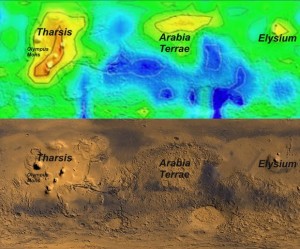20 December 2010
Unsolved mystery: The case of Martian methane
Posted by mohi

Map of methane concentrations on Mars (top) and a true colour map of Mars (bottom). Warm colors indicate methane plumes. Image courtesy of NASA/Università del Salento
There is methane in the Martian atmosphere, and it’s relatively abundant. But not only that, it peaks seasonally and in specific locations, suggesting that something–geological, chemical or maybe even biological–is burping methane.
Recently, a 6-year long study using images from NASA’s Mars Global Surveyor tracked the gassy emissions and found that concentrations peaked in late summer, then trailed off by winter. And some areas of the planet belch more than others–especially in the Northern Hemisphere. Several methane plumes were detected around the volcanic regions Tharsis and Elysium, and near Arabia Terrae, home to a large subterranean ice field.
That’s all good, but the problem is that no one knows what is producing the methane, or why it’s like a kid with a short attention span: most of the methane in the Martian atmosphere wanders off in less than a year, much more quickly than dissipating air should.
Something on Mars is acting as a methane ‘sink,’ or device for methane removal.
The mystery of disappearing methane was the topic of Raina Gough’s presentation during AGU Fall Meeting’s Friday morning’s session P52A, The Atmosphere of Mars: New Findings from Modeling and Observations II. Gough, from the University of Colorado, Boulder focused on finding chemicals in Martian dirt that might be involved methane depletion.
But she didn’t find anything that could explain the rapid disappearance of the gas, something that occurs in just 200 days. Degradation due to ultraviolet rays from the Sun–a process called photolysis–and oxidation in the lower atmosphere takes much, much longer. Like, years longer. But none of the chemical compounds Gough studied proved successful either.
“We had negative results for all systems studied,” Gough said.
Negative results are informative, though, as they help constrain possible avenues of investigation. For example, Gough tested whether hydrogen peroxide in the soil could help convert methane to carbon dioxide, the most abundant gas in the Martian atmosphere. Her results indicated that incredibly large amounts of hydrogen peroxide-containing soil would need to be present to create the observed methane depletion.
“In order for the methane to have a lifetime that matches the observation, you’d need to have about 500 meters of hydrogen peroxide-containing soil,” she said. “This is not a reasonable mechanism.”
Gough also tested whether perchlorate salts–sodium and magnesium–could act as a methane ‘sink’ and found that they could not.
“Something else is destroying methane on Mars,” she said. “Something I didn’t study.”
I hope it’s methane-munching Martian microbes. Green color optional…
–Nadia Drake is a science communication graduate student at UC Santa Cruz


 GeoSpace is a blog on Earth and space science, managed by AGU’s Public Information staff. The blog features posts by AGU writers and guest contributors on all sorts of relevant science topics, but with a focus on new research and geo and space sciences-related stories that are currently in the news.
GeoSpace is a blog on Earth and space science, managed by AGU’s Public Information staff. The blog features posts by AGU writers and guest contributors on all sorts of relevant science topics, but with a focus on new research and geo and space sciences-related stories that are currently in the news.